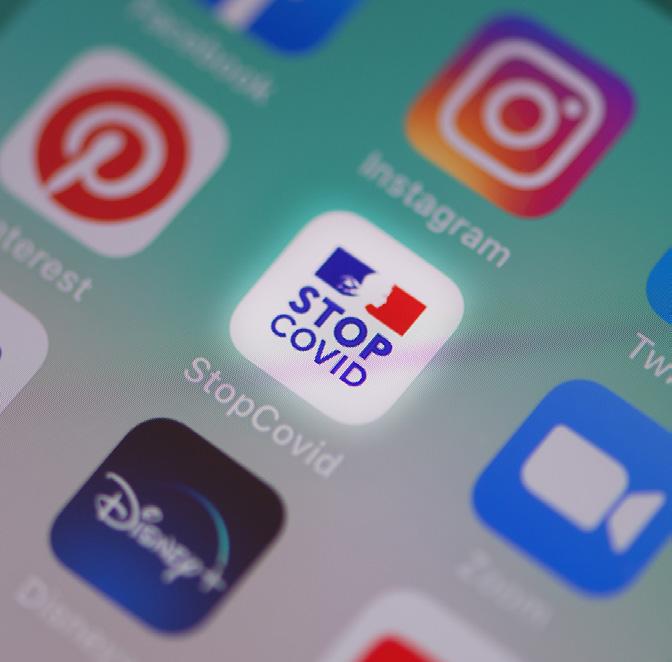
4 minute read
Contact Tracing Apps
The global pandemic caused by the COVID-19 virus has had a huge impact on almost all aspects of our day-to-day lives. We have had to change the way we work, meet, socialize, and relax. Technology has been critical in helping us manage the life-work changes mandated by the pandemic. One new application of technology that has emerged is a tech-enabled method for an old practice known as “contact tracing.”
While the term “contact tracing” is new to many of us, the practice is quite old. Public health officials have been doing contact tracing for decades as a very effective means of stifling outbreaks of communicable diseases. Once a person is identified as having a highly contagious disease, he or she is interviewed by a public health worker to determine who the infected person has been in contact with while contagious. Those individuals are then contacted and advised to self-isolate and get tested. The idea is to stop the spread of the disease by re-tracing the steps of the infected person, and isolating those who were in close proximity before they have had a chance to potentially spread the disease to their circle of contacts. The practice of contact tracing has become even more important with COVID-19, as some carriers of the virus can be asymptomatic and completely unaware that they may be infecting others around them.
So, how does technology change the way public health officials do contact tracing? It’s easy when you think about it. What is the one device that just about every one of us take with us virtually everywhere we go? Our smartphone. So, if someone tests positive for coronavirus, wouldn’t it be easy and save time for the contact tracers if that person’s phone had a record of all other phones (carried by people) that had been in close proximity to the infected individual over the past week or so? Yes. In theory, if smartphones could somehow keep a log of other phones that had been within six feet of the infected person’s phone, it could hypothetically go back and warn those other smartphone users that they had been potentially exposed to the virus. That is the idea behind using technology—and specifically smartphone technology—to conduct rapid contact tracing.
Apple and Google, who dominate the smartphone market, saw how useful smartphones could be in helping public health officials curtail the spread of the virus. In a rare joint venture, they developed a toolkit of sorts that app developers can use to build contact tracing apps. The Apple/Google toolkit, which works on both iPhone and Android phones, uses Bluetooth technology to automatically communicate with other smartphones within a certain proximity. A user would have to opt-in to the contact tracing app that uses this technology; but afterwards the system would work automatically without any prompting from the user.
So, if I had a contact tracing app on my phone that uses this technology, and I had opted-in to allow the tracing, my phone would emit a unique identifier using the Bluetooth signaling capability of the phone. Other smartphones that came within so many feet (say 6 feet) of my phone for a certain length of time (say 15 minutes) would record my unique identifier in their history log; and my phone would record their unique identifier in my phone’s history log. Then, if I happen to test positive for coronavirus, a public health official could take my phone and “see” the other phones that had been in close proximity to me within the past week. The public health official could then take those unique identifiers and automatically contact the users of those other phones via the app to let them know that they had been potentially exposed to the virus. What could go wrong?
Well, as it turns out, quite a few things could go wrong. First, for such a system to be effective, a large majority of the population would need to adopt it. A large majority of the population does indeed own a smartphone; but, so far, adoption of contact tracing apps has been nowhere near universal. While some countries have developed and released a universal contact tracing app for their citizens, the US has not developed—nor signaled intent to develop— any such federal app. Instead, the individual states have been left to develop contact tracing apps. Near the beginning of the pandemic, several states seemed eager to develop contact tracing apps for their citizens. As the pandemic has lingered, however, the promised contact tracing apps from state health officials have been few and far between. As of this writing, only three states—Alabama, North Dakota, and South Carolina— have requested access to the Apple Google toolkit to develop contact tracing apps. Another state, Utah, has gone out on its own, developing an app that is not based on the Apple/Google toolkit standard, raising questions about the ease of sharing information with other non- Utah apps.
There are already questions about privacy issues related to a contact tracing app; and Americans are reluctant to acquiesce to any type of government “tracking,” especially via their smartphones. If private companies—including for-profit entities—take up the slack and develop contact tracing apps, more questions may be raised about what these companies may be doing with information they gain access to from these apps and how they potentially can market this data for profit.
So, this idea of using smartphones to conduct contact tracing, while it is indeed technically viable, may not yet be accepted widely enough to be a practical solution. Perhaps more action from the CDC or WHO, who so far have shied away from developing or endorsing any contact tracing app, may be needed to make a widely accepted contact tracing app in the US a reality.






